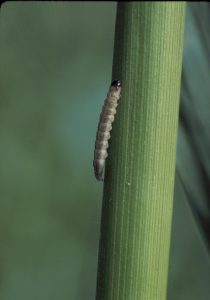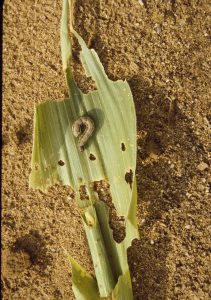Sweet Corn IPM Newsletter No. 2 — June 21, 2024
CORN EARWORM AND FALL ARMYWORM!
Early Arrival of Corn Pests Impacts Management of Early Corn
SITUATION
Early planted corn is in the late whorl to pre-tassel stage in the southern Maine. A few fields started under clear plastic or rowcovers is now silking. This week our pheromone traps have caught all three of the major sweet corn pests. Growers should be on the alert for feeding injury in the fields and be prepared to protect any silking corn.

European corn borer: Most locations saw flights of European corn borer moths this week. Pheromone trap catches indicate that moths are now active and laying eggs on the leaves of corn plants. We have found larval feeding in late whorl and pre-tassel corn at most sites, but below the recommended spray threshold of 15% injury, with the exception of one field in Biddeford which was over threshold and a spray on late whorl corn was recommended. When silking corn is present a spray is recommended if more than five European corn borer moths are caught in a week, if the field is not currently on a spray interval for corn earworm. Most fields scouted this week were not yet in silk so no spray was recommended. Moths were over threshold in Gray, but the field is now under a spray interval for corn earworm, which should also control corn borer.
Remember that sprays during the pre-tassel stage, when both moths and larvae are present, will control the larvae before they can move into the stalks and ears. Spray coverage of the entire plant at this point provides effective kill of the larvae as they move from one part of the plant to another. It is important to rotate the type of insecticide used. Materials registered for controlling European corn borer include Bacillus thuringiensis products (XenTari®, Dipel DF®), Avaunt®, Coragen®, Warrior II®, Lannate®, Baythroid®, Asana®, Radiant®, Delta Gold®, Mustang®, Sevin XLR® and Intrepid®.
Corn earworm: We’ve caught corn earworm moths in pheromone traps at many of our locations this week. Most of the catches were low numbers and not an immediate concern because the fields are not yet at the silking stage. Fields not yet in silk do not need to be protected from corn earworm. When corn earworm moths are caught at a site, all silking corn in the fields should be protected with regular sprays, following the recommended intervals in the table below. A five-day spray interval was recommended for our site in Gray, where we caught seven earworm moths and there was silking corn present.
A reminder: corn earworm larvae have become resistant to some products in the IRAC group 3A insecticides, e.g. Warrior, Asana, Pounce, Brigade, Hero, Declare, Delta Gold, Mustang, Fastac, Baythroid. It is recommended that these products should not be used alone to control CEW. Combining them with another material from a different IRAC group (e.g. Lannate, Coragen or Blackhawk /Radiant) will improve effectiveness.

Fall armyworm: We caught single fall armyworm moths at two locations this week. This is early for this pest, and there is speculation that the relatively mild winter allowed them to survive further north than usual. The larvae chew large, ragged holes in corn leaves. We have not yet found any feeding injury in the field. Larvae can also move into the ears through the silk channel, behaving similarly to corn earworm. Pheromone trap catches will indicate if there is a threat to silking corn, but fields are often on a spray program for corn earworm when fall armyworm is present, and both insects should be controlled.
Squash vine borer: We set up traps to monitor this pest this week, but growers should be on the lookout for damage on squash and pumpkin plants. See the New England Vegetable Management Guide for control options.
Sincerely,
David T. Handley
Vegetable & Small Fruit Specialist
Highmoor Farm
P.O. Box 179
52 U.S. Route 202
Monmouth, ME 04259
207.933.2100
UMaine Extension Diagnostic Research Lab
Pest Management Unit
17 Godfrey Drive
Orono, ME 04473
1.800.287.0279
| Location | CEW Moths | ECB Moths | FAW Moths | %Feeding Damage | Recommendations / Comments |
|---|---|---|---|---|---|
| Biddeford | 1 | 7 | 0 | 69% | 1 spray for ECB feeding on pre-tassel corn |
| Bowdoinham | 0 | 5 | 0 | No spray recommended (no silking corn) | |
| Cape Elizabeth | 0 | 7 | 0 | 4% | No spray recommended (no silking corn) |
| Dayton | 0 | 16 | 0% | No spray recommended (no silking corn) | |
| Farmington | 0 | 20 | 0 | 5% | No spray recommended (no silking corn) |
| Gray | 7 | 8 | 1 | 0% | 5-day interval recommended for silking corn |
| Lewiston | 4 | 1 | 0 | 4% | No spray recommended (no silking corn) |
| Lewiston II | 0 | 26 | 0 | 0% | No spray recommended (no silking corn) |
| Oxford | 0 | 10 | 1 | 2% | No spray recommended (no silking corn) |
| Wayne | 1 | 0 | 0 | 5% | No spray recommended |
| Wells I | 1 | 21 | 0% | No spray recommended (no silking corn) | |
| Wells II | 1 | 12 | 2% | No spray recommended (no silking corn) |
CEW: Corn earworm (Only fresh silking corn should be sprayed for this insect.)
ECB: European corn borer
FAW: Fall armyworm
| Moths caught per week | Moths caught per night | Spray Interval |
|---|---|---|
| 0.0 to 1.4 | 0.0 to 0.2 | No spray |
| 1.5 to 3.5 | 0.3 to 0.5 | Spray every 6 days |
| 3.6 to 7.0 | 0.6 to 1.0 | Spray every 5 days |
| 7.1 to 91 | 1.1 to 13.0 | Spray every 4 days |
| More than 91 | More than 13 | Spray every 3 days |
Thresholds apply only to corn with exposed fresh silk. Lengthen spray intervals by one day if maximum daily temperature is less than 80°F.
European Corn Borer Thresholds
Whorl stage: 30% or more of plants scouted show injury.
Pre-tassel-silk: 15% or more of plants scouted show injury.
Silk: 5 or more moths caught in pheromone traps in one week.
IPM Web Pages:
Explore Integrated Pest Management in Maine — UMaine
Integrated Pest Management Data Visualization Tool — Penn State
Integrated Pest Management — UMass Amherst
Where brand names or company names are used, it is for the reader’s information. No endorsement is implied nor is any discrimination intended against other products with similar ingredients. Always consult product labels for rates, application instructions and safety precautions. Users of these products assume all associated risks.
In complying with the letter and spirit of applicable laws and pursuing its own goals of diversity, the University of Maine System does not discriminate on the grounds of race, color, religion, sex, sexual orientation, transgender status, gender, gender identity or expression, ethnicity, national origin, citizenship status, familial status, ancestry, age, disability physical or mental, genetic information, or veterans or military status in employment, education, and all other programs and activities. The University provides reasonable accommodations to qualified individuals with disabilities upon request. The following person has been designated to handle inquiries regarding non-discrimination policies: Director of Equal Opportunity, 5713 Chadbourne Hall, Room 412, University of Maine, Orono, ME 04469-5713, 207.581.1226, TTY 711 (Maine Relay System).
